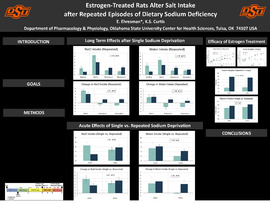| dc.contributor.author | Ehresman, E. | |
| dc.contributor.author | Curtis, K. S. | |
| dc.date.accessioned | 2020-05-05T19:37:38Z | |
| dc.date.available | 2020-05-05T19:37:38Z | |
| dc.date.issued | 2020-02-28 | |
| dc.identifier | ouhd_ehresman_estrogentreatedratsalter_2020 | |
| dc.identifier.citation | Ehresman, E., & Curtis, K. S. (2020, Feb. 28). Estrogen-treated rats alter salt intake after repeated episodes of dietary sodium deficiency. Poster presented at Research Day at Oklahoma State University Center for Health Sciences, Tulsa, OK. | |
| dc.identifier.uri | https://hdl.handle.net/11244/324187 | |
| dc.description.abstract | Background: Sex differences in sodium intake are apparent; however, estrogen's role in these differences is currently unclear. Previous studies examining repeated episodes of furosemide-induced sodium depletion showed that while stimulated salt intake was similar between males and females, there were clear sex differences in sodium intake after rats were sodium replete. We aimed to further elucidate the long-term effects of estrogen on sodium intake using repeated episodes of a low salt diet, a more physiological challenge. | |
| dc.description.abstract | Methods: Ovariectomized rats were placed on two-week periods of access to regular chow (NaR) or sodium deficient chow (NaD), which we alternated for a total of two exposures to each diet. Estrogen benzoate (EB) or oil injections were given twice weekly throughout the experiment. At the end of each diet period, rats were given a 2-hour two-bottle test (water and 0.5 M NaCl). At the end of the experiment, rats were sacrificed and trunk blood was collected and centrifuged to collect plasma. Plasma protein levels were measured. Uteri were collected and 1 cm segments of the uterine horns were weighed. | |
| dc.description.abstract | Results: We confirmed the efficacy of EB treatment via effects on body weight, uterine weight, and plasma proteins. Specifically, EB-treated rats maintained body weight throughout the experiment, with the expected transient decreases corresponding to the EB injection schedule, while oil-treated rats gained weight. In addition, both plasma proteins and uterine weights were greatly increased in EB-treated rats compared to oil-treated rats. During two-bottle tests, both EB- and oil-treated rats had similar baseline intakes of 0.5 M NaCl and water. When salt intake was stimulated by dietary sodium deficiency, both EB- and oil-treated rats drank similarly increased amounts of 0.5 M NaCl. Interestingly, EB- treated rats drank more 0.5 M NaCl and water than did oil-treated rats following return to regular chow. The second period of dietary sodium deficiency again elicited similar intakes of 0.5 M NaCl and water by EB- and oil-treated rats. | |
| dc.description.abstract | Conclusions: Our study demonstrated that estrogen did not alter salt intake induced by the physiological challenge, dietary sodium deficiency. However, the low salt diet led to persistent changes in behavior, as demonstrated by the continued consumption of salt and water by EB-treated rats even after sodium repletion. | |
| dc.format | application/pdf | |
| dc.language | en_US | |
| dc.publisher | Oklahoma State University Center for Health Services | |
| dc.rights | The author(s) retain the copyright of have the right to deposit the item giving the Oklahoma State University Library a limited, non-exclusive right to share this material in its institutional repository. Contact Digital Resources and Discovery Services at lib-dis@okstate.edu or 405-744-9161 for the permission policy on the use, reproduction or distribution of this material. | |
| dc.title | Estrogen-treated rats alter salt intake after repeated episodes of dietary sodium deficiency | |
| osu.filename | ouhd_ehresman_estrogentreatedratsalter_2020.pdf | |
| dc.type.genre | Presentation | |
| dc.type.material | Text | |
| dc.subject.keywords | estrogen | |
| dc.subject.keywords | sodium depletion | |
| dc.subject.keywords | salt intake | |
